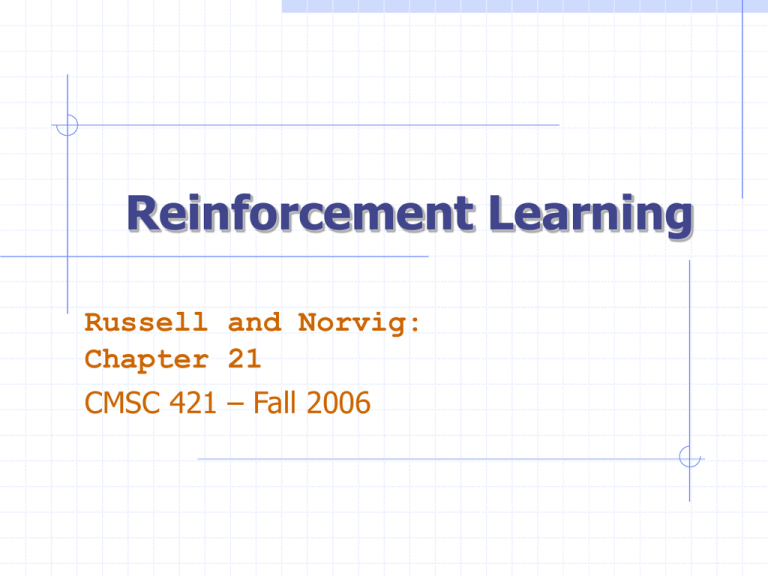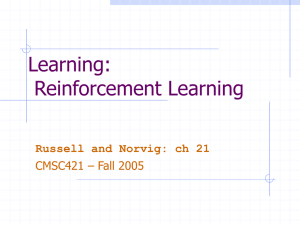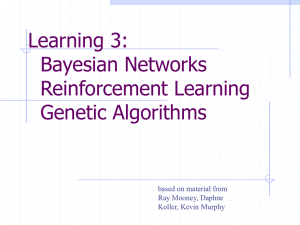Reinforcement Learning
advertisement

Reinforcement Learning Russell and Norvig: Chapter 21 CMSC 421 – Fall 2006 Reinforcement Learning supervised learning is simplest and best-studied type of learning another type of learning tasks is learning behaviors when we don’t have a teacher to tell us how the agent has a task to perform; it takes some actions in the world; at some later point gets feedback telling it how well it did on performing task the agent performs the same task over and over again it gets carrots for good behavior and sticks for bad behavior called reinforcement learning because the agent gets positive reinforcement for tasks done well and negative reinforcement for tasks done poorly Reinforcement Learning The problem of getting an agent to act in the world so as to maximize its rewards. Consider teaching a dog a new trick: you cannot tell it what to do, but you can reward/punish it if it does the right/wrong thing. It has to figure out what it did that made it get the reward/punishment, which is known as the credit assignment problem. We can use a similar method to train computers to do many tasks, such as playing backgammon or chess, scheduling jobs, and controlling robot limbs. Reinforcement Learning for blackjack for robot motion for controller Formalization we have a state space S we have a set of actions a1, …, ak we want to learn which action to take at every state in the space At the end of a trial, we get some reward, positive or negative want the agent to learn how to behave in the example: Alvinn environment, a mapping from states to actions state: configuration of the car learn a steering action for each state Reactive Agent Algorithm Accessible or Repeat: observable state s sensed state If s is terminal then exit a choose action (given s) Perform a Policy (Reactive/Closed-Loop Strategy) 3 +1 2 -1 1 1 2 3 4 • A policy P is a complete mapping from states to actions Reactive Agent Algorithm Repeat: s sensed state If s is terminal then exit a P(s) Perform a Approaches reflex agent: learn policy directly, function mapping from states to actions Q-learning: learns an action-value function, or Q function, giving the expected utility of taking a given action in a given state utility-based agent: learn utility values for states, use it to select actions that maximize the expected outcome utility Value Function An agent knows what state it is in and it has a number of actions it can perform in each state. Initially it doesn't know the value of any of the states. If the outcome of performing an action at a state is deterministic then the agent can update the utility value U() of a state whenever it makes a transition from one state to another (by taking what it believes to be the best possible action and thus maximizing): U(oldstate) = reward + U(newstate) The agent learns the utility values of states as it works its way through the state space. Exploration The agent may occasionally choose to explore suboptimal moves in the hopes of finding better outcomes. Only by visiting all the states frequently enough can we guarantee learning the true values of all the states. A discount factor is often introduced to prevent utility values from diverging and to promote the use of shorter (more efficient) sequences of actions to attain rewards. The update equation using a discount factor gamma is: U(oldstate) = reward + gamma * U(newstate) Normally gamma is set between 0 and 1. Q-Learning augments value iteration by maintaining a utility value Q(s,a) for every action at every state. utility of a state U(s) or Q(s) is simply the maximum Q value over all the possible actions at that state. Q-Learning foreach state s foreach action a Q(s,a)=0 s=currentstate do forever a = select an action do action a r = reward from doing a t = resulting state from doing a Q(s,a) += alpha * (r + gamma * (Q(t)-Q(s,a)) s=t Notice that a learning coefficient, alpha, has been introduced into the update equation. Normally alpha is set to a small positive constant less than 1. Selecting an Action simply choose action with highest expected utility? problem: action has two effects gains reward on current sequence in a rutand used in learning informationstuck received for future sequences trade-off immediate good for long-term well-being jumping off a cliff just because you’ve never done it before… Exploration policy wacky approach: act randomly in hopes of eventually exploring entire environment greedy approach: act to maximize utility using current estimate need to find some balance: act more wacky when agent has little idea of environment and more greedy when the model is close to correct example: one-armed bandits… RL Summary active area of research both in OR and AI several more sophisticated algorithms that we have not discussed applicable to game-playing, robot controllers, others




